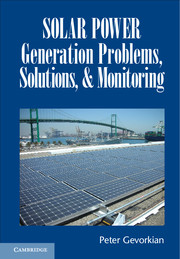Book contents
- Frontmatter
- Contents
- About the Author
- Foreword
- Preface
- Disclaimer Note
- Acknowledgments
- Peer Review of Solar Power Generation Problems, Solutions, and Monitoring
- 1 Types of Energy Sources and Energy Production and Use
- 2 Significance of Large-Scale Photovoltaic Solar Power Energy Production
- 3 Concentrator Photovoltaic Technology
- 4 Issues and Problems Associated with Large-Scale Solar Power Systems
- 5 How to Design and Specify Large-Scale Solar Power Systems
- 6 Solar Power Construction and Project Management
- 7 Solar Power Financing
- 8 Large-Scale Solar Power System Legal Issues
- 9 Proposed Advanced Photovoltaic Solar Power System Technology Requirements
- 10 Microinverters and Peak Power Tracking (PPT) Technologies
- 11 Advanced Solar Power Generation and Integration with Smart Grid
- 12 Large-Scale Energy Storage Systems
- Appendix A Glossary: Solar Energy Power Terms
- Appendix B Feasibility Study and Example
- Appendix C Solar Power System Tests
- Appendix D Bakersfield, California, Solar Power Fire
- Appendix E U.S. Statewide Solar Initiative Programs and International Tariffs
- Appendix F Alternative and Solar Power Engineering Studies Program
- Appendix G Historical Timeline of Solar Power Energy
- Index
Appendix D - Bakersfield, California, Solar Power Fire
Published online by Cambridge University Press: 05 March 2016
- Frontmatter
- Contents
- About the Author
- Foreword
- Preface
- Disclaimer Note
- Acknowledgments
- Peer Review of Solar Power Generation Problems, Solutions, and Monitoring
- 1 Types of Energy Sources and Energy Production and Use
- 2 Significance of Large-Scale Photovoltaic Solar Power Energy Production
- 3 Concentrator Photovoltaic Technology
- 4 Issues and Problems Associated with Large-Scale Solar Power Systems
- 5 How to Design and Specify Large-Scale Solar Power Systems
- 6 Solar Power Construction and Project Management
- 7 Solar Power Financing
- 8 Large-Scale Solar Power System Legal Issues
- 9 Proposed Advanced Photovoltaic Solar Power System Technology Requirements
- 10 Microinverters and Peak Power Tracking (PPT) Technologies
- 11 Advanced Solar Power Generation and Integration with Smart Grid
- 12 Large-Scale Energy Storage Systems
- Appendix A Glossary: Solar Energy Power Terms
- Appendix B Feasibility Study and Example
- Appendix C Solar Power System Tests
- Appendix D Bakersfield, California, Solar Power Fire
- Appendix E U.S. Statewide Solar Initiative Programs and International Tariffs
- Appendix F Alternative and Solar Power Engineering Studies Program
- Appendix G Historical Timeline of Solar Power Energy
- Index
Summary
The High-Voltage Task Group (HVTG) established by the TCC proposed making this Code-wide change to address the higher DC system voltages that are common in wind generation and PV systems. As noted in the National Electrical Code Committee Report on Comments (ROC), PV systems “are currently being installed at dc voltages over 600 V up to and including 1,000 V, 1,200 V, 1,500 V and 2,000 Vdc.” To keep the Code in sync with evolving product standards and installation practices, the HVTG determined that the Code-wide approach was called for, starting with Article 490.
The rationale behind the HVTG's proposal for the new 1,000-volt threshold is explained in the ROC: “If the NEC does not adequately address systems over 600 volts, some other standard will. If we want to control the future safety of installations over 600 volts, we need to address these issues today.” The HVTG also notes: “Moving the NEC threshold from 600 volts to 1,000 volts will not, by itself, allow the immediate installation of systems at 1,000 volts. Equipment must first be tested and found acceptable for use at the higher voltage(s).”
In other words, elevating the high-voltage threshold does not magically turn 600-volt–rated equipment into 1,000-volt–rated equipment. Not only does equipment used in 1,000-volt systems need to be evaluated and listed at 1,000 volts, but so do the meters, tools, and personal protective equipment installers use. It is also important for PV system designers and installers to note that references to 600 volts were not universally changed to 1,000 volts throughout the entire Code. For example, Part II of Article 110 is still titled “600 Volts, Nominal, or Less” and Part III is still “Over 600 Volts, Nominal.” This means that pre-existing voltage thresholds for working space requirements and minimum distances from live parts and so forth are carried over into the new Code edition. Further, the maximum allowable PV system voltage for one– and two-family dwellings is still 600 Vdc, as stated in Section 690.7(C). (For more information on designing and deploying Code-compliant 1,000-volt PV systems, see “1,000 Vdc Utilization Voltages in Non-residential PV Applications,” SolarPro magazine, April/May 2013.)
PV-Specific Code Changes
Articles in NEC Chapter 6 apply to “Special Equipment,” and Article 690 applies specifically to PV systems.
- Type
- Chapter
- Information
- Solar Power Generation Problems, Solutions, and Monitoring , pp. 391 - 394Publisher: Cambridge University PressPrint publication year: 2016



